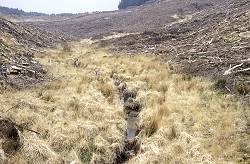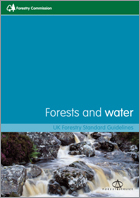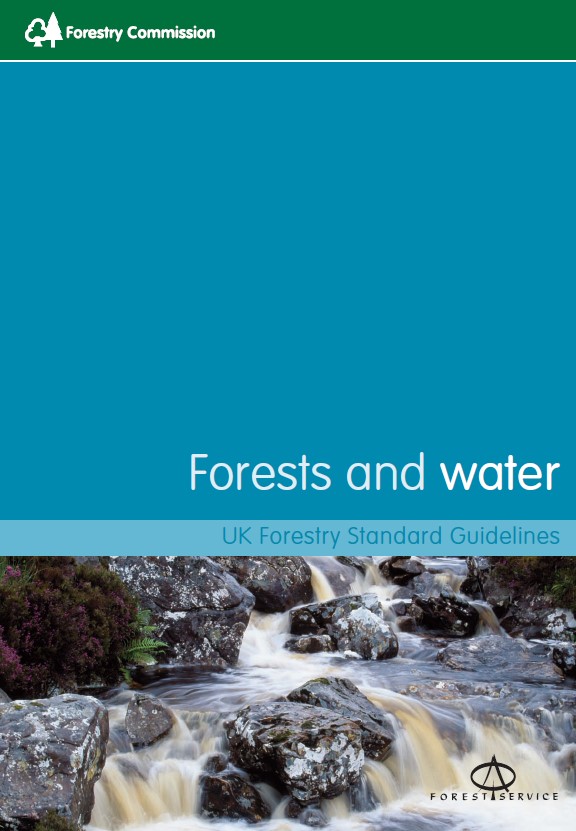Summary
Forests play a major role in the ecological functioning of the freshwater environment. Forest streams, rivers, lakes, ponds and wetlands all provide habitat for a large range of plant and animal species. Several protected and priority species such as otters, water vole, Atlantic salmon and freshwater pearl mussels are particularly associated with woodlands.
To meet UK Forestry Standard requirements, forest design and management must restore and maintain the natural features, processes and habitat of the freshwater ecology. The water elements of the forest must be considered in the preparation of forest design plans and all forest operations to ensure the freshwater biodiversity is protected and the water resource suitable for a range of purposes.
Management of forest riparian buffer areas
The following management recommendations for UK forestry are based on an international literature review.
Catchment management plan: management of riparian woodland should be based on a consideration of site sensitivity, intrinsic value and potential. A strategic plan for the forest should be prepared in consultation with local stakeholders.
Width: the riparian buffer should reflect stream size and the natural dimensions of the functional riparian zone. The recommended widths ranged from 5 m for stream up to 1 m wide to over 2+ m for streams >2 m wide. Where the natural riparian zone exceeds these widths, the dimensions of the buffer area should be increased, up to twice the minimum recommended width.
Canopy structure: establish and maintain a variable, predominantly open woodland canopy with half the watercourse open to sunlight and the remainder under dappled shade.
Species choice: the vegetation established within the riparian buffer should be native and appropriate to the location and soil water regime. In the UK the Ecological Site Classification toolkit can be used to identify suitable species.
Establishment method: natural regeneration is considered the best method of establishing native tree and shrub species where an appropriate seed source exists. Where natural regeneration is unsuitable tree planting sites should be prepared by mounding, either by hand or using a lightweight excavator to minimise trafficking. No drainage is permitted within a riparian buffer and very wet sites should be left unplanted. Planting should favour light-foliaged species in irregular small groups to replicate the vegetation structure of a secondary forest.
Canopy maintenance: the level of shade should be assessed regularly to determine the need for canopy management. Areas of dense shade may require selective pruning, thinning, pollarding or coppicing. Thinning or group felling operations within the riparian buffer should be carefully planned to minimise site disturbance.
Dead wood and veteran trees: Dead wood forms an important habitat for many species associated with the shaded and moist conditions of riparian woodland. Veteran trees should be identified, mapped and retained where possible as they often provide important habitats and character to the area. Debris dams are natural features of wooded streams and greatly enhance the aquatic habitat. They should not be removed unless downstream sites are at risk of flooding from debris blockage or they form a significant barrier to migratory fish.
Structural engineering: In severely eroded streams, consideration should be given to reinforcing stream banks through the use of gabions or timber groynes. These will reduce hydraulic scouring of the banks creating deeper stream channels and facilitate the establishment of marginal vegetation.
Forest operations within the riparian zone: A riparian buffer must not be used to store equipment, fuel, oil or chemicals due to the high risk of leakage polluting adjacent watercourses. During harvesting operations on the adjacent land, care should be taken to avoid brash being deposited within the riparian buffer area. Stream crossings should be avoided, and temporary culverts created when this is not possible. The drainage system on restock sites should be designed so that drains terminate beyond the edge of the riparian buffer.
Riparian woodland creation to improve and protect the freshwater environment
Targeted woodland creation can significantly improve water quality. Woodland planting along watercourses replaces the agricultural activities in areas that typically form the main source zones for diffuse pollutants. Riparian woodland planting is an effective intervention to buffer the effects of the polluting agricultural activity in the wider catchment.
Research Objectives
Quantify the effectiveness of riparian woodland creation as a measure to improve water quality.
- PESFOR-W review
- Woodland creation for clean water
Identify options to target effective woodland creation to improve freshwater ecology in case study catchments
- A tree strategy for River Avon and River Frome
Support national initiatives to encourage riparian woodland creation
- The Riverwoods project is a new partnership focused on woodland creation to expand the national riparian woodland network and ensure healthy, resilient river systems throughout Scotland. The project is led by Scottish Wildlife Trust, Forest Research is a member of the project board
- Keeping Rivers Cool
- Land use change project
The impact of conifer clearance from the banks of upland streams
 Over the last 20 years, the Forestry Commission has been gradually clearing back conifer plantations from streamsides to create riparian buffers.
Over the last 20 years, the Forestry Commission has been gradually clearing back conifer plantations from streamsides to create riparian buffers.
A collaborative project was set up in the mid-1980’s to guide and inform the practice in upland forests in the UK. Three sites were established in Scotland and Wales to assess the impact of forest clearance on stream water chemistry and/or aquatic invertebrate and fish populations. These sites were recently revisited some 10 to 15 years after the original clearance to establish the medium term effects on the freshwater environment.
The results suggest that bankside clearance can improve the quality of riparian and aquatic habitat with increases in invertebrate abundance, diversity and fish stocks. However, bankside clearance will have a minimal effect on biological recovery in acidified catchments until chemical recovery is well underway.
Key findings from the final report (see right) are given below.
Riparian habitat quality
- Cleared streams tended to have the best quality of habitat. Uncleared sections had bare, eroding stream banks, while open pasture sections frequently had damaged banks due to overgrazing and trampling.
- Cleared streams with relic broadleaf trees and shrubs or where broadleaf trees were replanted after felling had the highest habitat scores.
- Bankside clearance had little effect on the cover of marginal and in-stream vegetation.
- Cleared streams with relic broadleaved trees tended to have more woody debris dams, which helped to create structural diversity in the in-stream habitat.
- Natural regeneration was very slow where there was an inadequate seed source or grazing by sheep. Light to moderate shading by the canopies of relic broadleaves controlled grass growth and increased the diversity of vegetation.
Macroinvertebrate abundance and diversity
- There was little evidence that bankside clearance affects the diversity of benthic invertebrates. The main effect was to increase invertebrate abundance, but this appears to have been limited to certain acid sensitive species, which were absent from acidic streams.
- Acidic moorland and ‘young’ cleared streams may have a lower invertebrate abundance than uncleared conifer streams due to the lack of allochthonous input.
Fish
- Bankside clearance has the potential to increase numbers of fry, parr and adult trout where other factors such as acidity and access are not limiting. Increases are thought to be mainly due to improved carrying capacity through better cover and food.
- The development of overhanging vegetation, undercut banks and pools is particularly beneficial in providing shelter for older fish. In time, heavy shading may reverse these benefits unless controlled by active management.
- Coarse woody debris dams can provide a serious barrier to fish movement where they become sealed by tree stumps, brash and silt. The condition of dams needs to be assessed after harvesting and cleared or cleaned where required, otherwise they will prevent upstream recolonisation.
General Content
SR0206F The Effect of Riparian Forest Management on the Freshwater Environment 2002 [Report]
The role of riparian shade in controlling stream water temperature in a changing climate
Our research project investigates the role of riparian woodland in controlling stream water temperature through the provision of shade. Observations in recent summers show that stream water temperatures in open streams draining southern England can greatly exceed tolerance levels for salmon and trout. The situation is expected to get worse with average temperatures predicted to rise by between 2 and 5 ºC by the end of this century. The influence of riparian woodland in limiting rises in water temperature is being investigated at several sites in England and Scotland.
Findings and Recommendations
Some fish species such as salmonids (salmon and trout) are very sensitive to high water temperature, with possible effects on the timing of spawning, fish growth rates and even survival. Salmonid fish require temperatures of between 5 and 15 ºC for normal growth and temperatures above 24 ºC can be lethal. Temperatures in excess of 31ºC have been recorded in recent summers in small lowland streams in the New Forest, demonstrating that this tolerance limit is already being significantly breached in some small watercourses in southern England.
Riparian woodland features such as, exposed tree roots, fallen stems and large woody debris dams, create structural diversity in the in-stream habitat and maintain pockets of cool water below undercut river banks and deep pools. These provide important thermal regulation for salmonids.
Riparian woodland canopy may require management to maintain water temperatures within a favourable range for salmonid fish and other sensitive freshwater fauna.
The shade provided by riparian trees can significantly reduce peak summer water temperature. Planting trees on river banks may therefore have an increasingly important role to play in limiting the impact of climate warming on freshwater life. Riparian woodland creation is the key objective of the Keeping Rivers Cool project, which is currently being led by the Woodland Trust.
Our Involvement
A joint field study with Southampton University was set up in the New Forest to evaluate the cooling effect of riparian shade.
Twenty sites with variable levels of shade on the Dockens Water and Ober Water have been instrumented to characterise the thermal regime and assess the effects of shading on streamwater temperature and on fish populations, including fish survival, growth rates and behaviour.
The results will help to determine whether thermal stress poses a serious problem in these watercourses and if so, how riparian woodland management could help to protect the freshwater life from future rises in water temperature.
Research Objectives
- To improve our understanding of how forest management influences freshwater habitats and their biodiversity
- Investigate the role of riparian shade in controlling stream water temperature
- Guidance on the management of riparian buffer areas within commercial forests
- The role of forestry in the protection of the Freshwater Pearl Mussel
- Guidance on the consideration of the freshwater environment in the preparation of Forest Design Plans
- The impact of conifer clearance from the banks of upland streams on freshwater ecology
- Monitor the impact of Beaver introduction on the public forest estate
- The influence of riparian woodland on the ecosystem function and degradation of small water bodies
General Content
What’s of interest
The Management of semi-natural Woodlands: Wet Woodlands (PDF-1096K)
Forestry Commission Practice Guide


